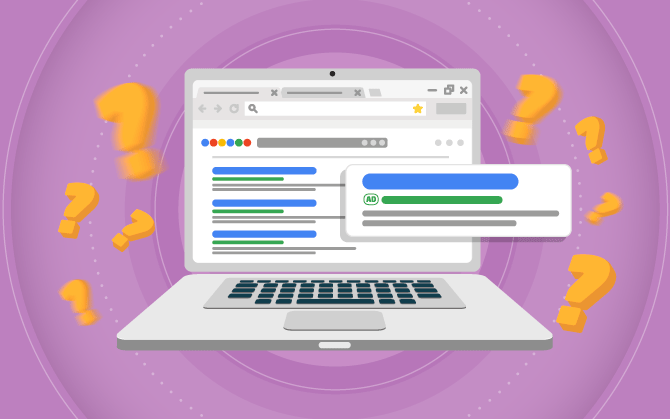
What are sponsored links and how does online advertising work?
Learn more about the simple texts that appear prominently in the first places of search engines.

What will we see in this post
You already know that content marketing is a great way to attract new customers in an organic manner. But if you’ve used this strategy, you’ve probably noticed that it bring results in the long term.
For those who need to attract an audience quicker, online advertising may be a great option.
Among the various forms of advertising, there are sponsored links, which are campaigns that appear prominently at the top of search results.
Would you like to learn more about this subject? Read on.
What is a sponsored link?
The name itself helps you understand this strategy, doesn’t it?
Because that’s it, paid links that your audience can click on.
These links are provided with simple texts and can usually be found at the top results of search engines such as Google.
Have you ever noticed that when you enter a term, at the top of the list there are a few results in the form of ads? Those are sponsored links.

But in addition to Google, other websites also allow the possibility of investing in sponsored links.
Facebook and Instagram, for example. Both have their own ads, which is a good option due to the high number of accesses that both media channels have.
Regardless of the channel, either one has similar ad formats on their platforms, despite the three networks being generally used for different strategies.
Google focuses on user searches. How? You invest in a link focused on a certain keyword.
For example:
Let’s suppose that you work as a designer in Chicago. When you advertise your website, you invest in the term “Designer in Chicago”. Whenever a user enters this term in the search, your name may appear.
Of course, there are other particularities, but in short, this is how sponsored links work.
What you should know about the subject
Despite being used in different strategies in each channel, sponsored links almost always have a few definitions in common, wherever they are displayed.
These are strategic terms that you need to know in order to run a successful online ad. And we’re going to talk a little about the most important ones.
Conversion
If you’re new to the digital market, you are probably wondering what conversion actually means.
In digital marketing, conversion is nothing less than the true goal of a strategy: to attract customers.
If, for example, your strategy is to distribute eBooks so that your users can learn how to “use Adobe Photoshop”; conversion happens when they enter your landing page and purchase your eBook.
However, a click on your ad doesn’t always turn into a conversion. But this is an indicator that you need to know before you create your ads.
CPC (Cost per click)
In short, CPC is the amount charged for each user click on your ads.
This is the model usually adopted by those advertising on Google Ads, but it’s also the ideal indicator for those who wish to know the exact value they are spending on an ad.
It’s an easy figure to calculate and measure, making it the best option for those who are getting started.
The CPC calculation is the result of the division of the total amount spent on ads per clicks received during the campaign.
CPA (Cost per acquisition)
CPA is only charged whenever there’s a conversion on your website, i.e., only when a user who clicks on your sponsored link makes a purchase.
This seems like the best way to invest in ads, right?
However, there are several requirements in order to use the cost-per-acquisition format. Among them, having at least 15 conversions over 30 days, and that you campaign on Google Ads has the conversion tracker feature activated.
When you purchase a CPA package, your online ad will be automated, which means that you’ll have less control over the positioning of your ads and will face certain variables such as the click rate and the ad’s text quality.
Before opting for this method, perform tests with other types of pricing to assess if the CPA is really the best option for you.
It’s also important to know that by using this method, you won’t necessarily spend less on sponsored links.
CTR (Click through rate)
CTR is a metric that checks the proportion between the number of times your ad was displayed and the number of clicks it received.
It’s through this metric that you check if your sponsored links strategy has worked.
Through CTR, you can assess which ads and keywords present good results and filter those that need to be reassessed.
For example, Google evaluates your CTR when it places your ad in a search result.
In order to have a powerful CTR, you need to pay attention to the digital market techniques, such as good CTAs (calls to action), for example.
So, it’s definitely a good idea to keep up to date with a few SEO tips. When it comes down to it, they are very fundamental to your strategy.
Is investing in sponsored links worth it?
You’ve probably noticed that sponsored links are quite suitable for short and medium-term strategies. If that’s your case, they might be a good option for you.
It all depends of course, on the type of keyword you wish to use and on your creativity when developing an ad. But even then, it’s important to learn about ads in order to build them in the best possible way and add them to your content marketing strategy.
Would you like to learn more about this?
Read our text that teaches you how to buy traffic and run your ads today.




